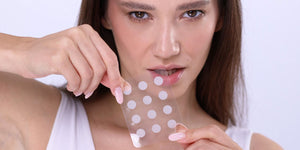You might’ve heard about hydrocolloid bandages being used more and more frequently lately. You can find them in all pharmacies, in drugstores and everywhere online as well. They come in all sorts of shapes, colors and sizes, depending on your needs and preferences. Although it may sound like a new invention, this type of patches has been used, in fact, for many, many years for light wound healing.
In case you want to learn more about hydrocolloid bandages for acne and how to also use them for different types of wounds, when not to use them, how to apply them, how to remove them without damaging the skin and more, the article below will provide all the information you need, together with a conclusion about whether they work or not.
What are hydrocolloid bandages?
A hydrocolloid band-aid, also known as a hydrocolloid dressing, is a type of bandage used for light wound care. It contains a substance called ‘hydrocolloid gel’, hence the name, and it’s used to protect wounds. It also helps creating a faster healing condition for the affected areas, away from bacteria and other external factors.
Hydrocolloid patches come in different sizes and shapes, fit for different wounds, and they’re very affordable as well. It’s a type of wound care that can be found easily, from drugstores to online stores all around the world.
Your go-to solution kit for clearing late-stage whiteheads overnight, 72pcs
Your zit-free emergency kit for reducing early-stage painful & deep pimples, 18pcs
How do hydrocolloid bandages work?
Hydrocolloid bandages come in different shapes and sizes, but they all work on the same system. Hydrocolloid patches are made of two different layers, each with its own role, as follows:
- A waterproof backing (the outer layer), usually transparent and made of thin foam or foil. Its role is to protect the wound and seal it from external factors such as bacteria, debris or dust. This outer layer also creates a moist environment that promotes faster healing, hence contradicting the myth according to which open wounds heal faster when exposed to air. In fact, wounds need moisture to heal, which is why this type of bandages have been proven to work.
- An inner layer made of hydrocolloid adhesive with gel-forming properties, that comes in direct contact with the wound. This layer protects the affected tissue and helps its healing by absorbing the moisture from inside, thus transforming into a hydrating gel. This inner layer will help the wound heal from the inside out.

How to apply hydrocolloid bandages
One of the best things about hydrocolloid surface patches is that they’re very easy to use. There are a few very simple steps you need to follow before and during the application of the bandages:
- Wash your hands thoroughly;
- Clean your wound with appropriate wound cleanser or simply with saline water;
- Pat your wound dry or wait until it completely air-dries before applying the bandage;
- Apply a thin layer of moisture such as a wound cream or ointment;
- Remove the protective film from the hydrocolloid bandage – make sure you’re using a patch that’s a bit larger than your wound (3-5 centimeters wider), so it will cover it completely;
- Apply the hydrocolloid bandage by folding it in half and sticking it from the center outward;
- Smooth it with your hand by applying a bit of pressure and hold for a bit so that you ensure the bandage completely adheres to the wound.
- Done!
How to remove hydrocolloid bandages
Removing the bandages is just as easy as applying them; here are the steps you need to follow:
- Gently press on the skin near the edges of the bandage;
- Carefully lift up the edges;
- Peel the entire bandage
In case your wound is not completely healed and you need to reapply a new hydrocolloid bandage, use the above-mentioned steps.
Hydrocolloid bandages for scars
It is said that hydrocolloid patches are useful because they provide less scarring on the wound. The explanation is simple – regular bandages must be detached and changed daily, sometimes even more often. This process sometimes implies some surface trauma during which some of the newly created tissue gets broken, creating drainage and an even longer healing time.
Because hydrocolloid bandages are flexible and durable, they don’t need to be changed for 3 to 7 days (as long as they don’t detach from the corners). This promotes faster healing without any interruption. After 5-6 days, light wounds are usually almost completely healed, which means you won’t affect the tissue when detaching your hydrocolloid bandage.

What are hydrocolloid bandages used for?
Hydrocolloid bandages can’t be used on any type of wound. This type of dressings is appropriate on wounds that have no drainage (or very little drainage) and that aren’t very deep. Moreover, your wound needs to also be clean, dry and, most of all, free of any sign of infection.
Hydrocolloid patches are a very good solution for areas that are difficult to treat or areas that have a lot of motion, for example elbows or knees. Because these areas often get in touch with your clothes or other surfaces during the day, it’s quite difficult to apply creams or other treatments on them that will also last for longer hours. The fact that hydrocolloid strips are flexible while also staying in place makes them an excellent solution for this type of wounds.
Because hydrocolloid strips are created so that they can be left on the wound for a longer time, you shouldn’t remove them to clean the tissue daily. This means that, in case of infection, you won’t be able to see or detect it underneath the protective bandage layer. This is why you should make sure there’s no sign of infection, debris or dirt on the wound before applying the strip.
This type of plasters work on recently healed blisters and wounds as well, preventing scarring. You can apply them on wounds that are in the process of healing or wounds that have granulation tissue on top; this type of tissue often times needs protection from light or harsh surface trauma that might affect it.
Hydrocolloid bandages for acne
Moreover, you can also use hydrocolloid bandages for acne. These are also known as pimple patches and their interior layer contains hydrocolloid combined with some other acne-healing ingredients such as salicylic acid or tea tree extract.
Hydrocolloid pimple patches are suitable for whiteheads and pus-filled blemishes. They don’t work on cystic acne or on hormonal acne.
This type of hydrocolloid bandages must be left for some hours, usually overnight, then changed in the morning. They’re not the same as the patches used to treat wounds, that can be left on the affected tissue for up to one week.
Acne patches work on the same principle; they absorb the liquid inside the blemishes and also protect the skin from bacteria and from picking.
When shouldn’t you use hydrocolloid bandages?
Hydrocolloid strips must be used on light, leak-free wounds, with medium thickness and depth. It’s not recommended to use them on very thick wounds, wounds that require drainage or on wounds that require frequent assisting such as cleaning, applying a cream treatment etc.
Moreover, you shouldn’t use hydrocolloid bandages on wounds that present any sign of infection. It’s recommended to first treat the infection and the deeply affected tissue and only use hydrocolloid strips afterwards, for light healing.
Last but not least, patients with sensitive skin might not react well to the adhesive layer of the strips and fragile skin might suffer from trauma after the removal of the strip.
It’s good to keep this information in mind when deciding if hydrocolloid bandages are appropriate for your specific situation or not. In case you’re not sure, it is strongly advisable that you contact your family doctor and ask for further guidance.
Bottom line – Hydrocolloid bandages really work!
It was proven that hydrocolloid bandages work if applied on the suitable kind of wound. The gel-forming properties of hydrocolloid are very useful with treating wounds and preventing scarring.
Hydrocolloid patches come with a handful of advantages:
- They’re extremely easy to use
- Affordable
- They can be kept on the skin for 3 to 7 days – you don’t need to clean and treat the wound daily
- They provide faster healing
- They reduce the risk of infection by protecting the open wound from external factors such as bacteria
- Little to no scarring
By creating a flexible, waterproof barrier that protects the affected skin area and that creates a moist, hydrating environment that will help the wound heal from the inside out, hydrocolloid bandages really work in treating various kinds of wounds.
Where to buy hydrocolloid patches from
Check out our collection of pimple patches, for both deep zits and whiteheads.
Hugs!
Adrienne | Co-founder of OMMA Cosmetics
Photo sources: OMMA





